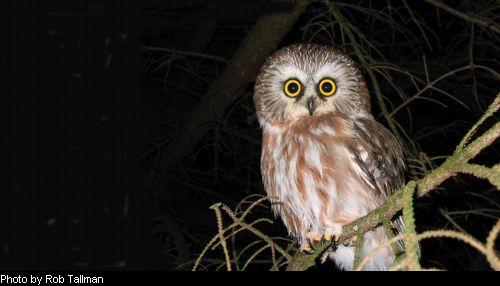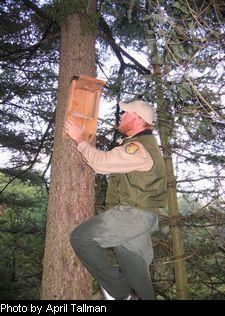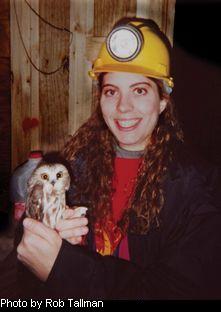
Although most saw-whet owls pass through West
Virginia during migration, a small breeding population exists.
A Look At Our Smallest Owl
By Rob Tallman
Here you are, high on a mountain in the Cranberry Wilderness surrounded
by a dense red spruce forest. The sun is setting and the woods are
growing dark. The thrushes sing the last few verses of their evening
chorus and the forest around you becomes silent. The stage is set for
the long quiet night ahead.
Then, out of nowhere, just outside the light of your fading campfire;
an incessant, monotonous TOOT….TOOT….TOOT….TOOT….TOOT….TOOT….TOOT
begins and lasts for what seems like forever. You haven’t a clue
as to what’s producing this annoying noise, a sound much like
the back-up alarm on a garbage truck! After all, you’ve spent
nights in the high country, but never experienced anything such as
this. Consider yourself fortunate. You have just encountered one of
the Mountain State ’s rarest and most secretive creatures--the
northern saw-whet owl. The northern saw-whet owl is a bird of the northern
boreal forest with a relatively small but stable breeding population
extending down the spine of the Appalachians through West Virginia
and into the Smoky Mountains of Tennessee and North Carolina . The
adult saw-whet’s plumage consists of a rusty-brown streaked underside
and a darker brown back and wings with white or buffy colored spots
throughout. The juvenile is mostly chocolate brown with a conspicuous
white “V” on its forehead. The plumage of both age classes
is set off by distinctive large yellow eyes.
The saw-whet’s most endearing feature is its size. It is the
smallest owl in West Virginia , weighing in at 2.6 to 3.5 ounces (75
to 100 grams), slightly larger than the American robin. Don’t
let its small size fool you, however, as it is a very efficient predator,
feeding mainly on mice as well as other small mammals. Northern saw-whet
owls are strictly nocturnal, feeding throughout the night and remaining
well hidden during the day.
Northern saw-whet owls, a cavity-nesting species, will use natural
cavities created by woodpeckers but will also use man-made nest boxes.
In West Virginia , saw-whets begin displaying courtship behavior in
early March. Typically, the female lays five or six eggs by mid-April
and incubates them for three to four weeks. In most years the young
have fledged by early June.
Unlike other common West Virginia owls, saw-whets are migratory.
Most of the eastern population (including those breeding in Canada
and the Appalachians ) winters in the southeastern United States .
In West Virginia , saw-whets begin their southward migration in early
October and may continue into early December, with the peak migration
occurring around Halloween. The spring migration is thought to occur
during February and into early March, but, as with many migratory birds,
their spring migration is much less concentrated and poorly understood.
The number of saw-whets migrating each year is highly variable and
is thought to be based on the cyclic nature of the small mammal populations
upon which they feed.
Even though considerable research has been conducted in the northern
portion of the saw-whet’s range, relatively little has been conducted
in the central and southern Appalachians . This research need is especially
important since suitable breeding habitat is restricted to high elevation
red spruce forests and migration patterns as a whole are poorly understood.
In response to this research need the West Virginia Division of Natural
Resources Wildlife Diversity Program initiated three studies to better
understand the migration patterns, breeding distribution and abundance
of the Northern saw-whet owl in the state.
The first study, initiated in 1997 through a research grant from
the Wildlife Diversity Program, established a northern saw-whet owl
fall migration banding station in  Randolph County . The station began
operations in the fall of 1997 on Shavers Mountain but was moved to
Stuart Knob just east of Elkins in 2000. More than 600 saw-whets have
been captured and banded at this station since its inception. Migrating
saw-whets are attracted using an audio lure recording of their call
set up in front of a line of nearly invisible nets, called mist nets.
The owls fly in to investigate the call and become entangled in the
nets. Randolph County . The station began
operations in the fall of 1997 on Shavers Mountain but was moved to
Stuart Knob just east of Elkins in 2000. More than 600 saw-whets have
been captured and banded at this station since its inception. Migrating
saw-whets are attracted using an audio lure recording of their call
set up in front of a line of nearly invisible nets, called mist nets.
The owls fly in to investigate the call and become entangled in the
nets.
Once an owl is captured, biologists weigh the owl, measure its wings
and tail, note the eye and bill color, determine the age and sex, and
place a numbered aluminum band on its leg before releasing it. If that
owl is ever captured again or found dead, anywhere, the number on its
leg band can be traced and valuable information on migration patterns,
life span and general natural history will be gained. The Stuart Knob
banding station is one of a network of over 50 such stations across
the United States and Canada. Each fall several thousand saw-whets
are banded at these stations and many recaptures are noted, providing
key information on saw-whet behavior.
The second and third studies are designed to ascertain the distribution
and population density of northern saw-whet owls in the state. A nestbox
placement program began in 2001. To date, 135 saw-whet owl nestboxes
have been placed in appropriate habitat in Pocahontas, Randolph, Tucker
and Webster counties. DNR personnel will place another 75 nestboxes
this fall. Only three of these boxes have had evidence of breeding
saw-whets since 2001. However, given the fact that less than 12 confirmed
breeding records have ever been recorded in the state, the nestbox
program has made a significant contribution to our knowledge of the
northern saw-whet owl in West Virginia.
DNR personnel and volunteers check nestboxes each April for breeding
evidence. If a nestbox is occupied, it is revisited in May so that
both parents and young can be banded. In addition, all the same measurements
are taken as mentioned above for fall migrating birds.
The third study is an audio playback survey designed to elicit responses
from territorial breeding saw-whets in order to gain an understanding
of the distribution of breeding pairs. DNR biologists conduct these
surveys in early April when most saw-whets are highly territorial.
This is a roadside survey conducted by broadcasting the call of the
saw-whet through a loud speaker at half-mile intervals. Any territorial
saw-whet owls in the area perceive this broadcast call as another saw-whet
invading their breeding territory and respond by flying in and calling
back, occasionally even dive bombing the loud speaker! This survey
method enables DNR biologists to estimate the number of breeding pairs
in an area that otherwise would go undetected due to their secretive
nature. This is also helpful in the placement of nestboxes into appropriate
habitat.
Even though occurrences of the northern saw-whet owl are relatively
rare in West Virginia, it is likely that this species is, in appropriate
habitat, more common than once thought. However, the only way to determine
this is by way of studies currently underway. So the next time you
find yourself in West Virginia’s high country, remember to keep
an eye (or an ear) out for this small, secretive owl.
Rob Tallman is a wildlife biologist stationed in Elkins.
|
Whooooo Needs You?
The future success of these studies is largely dependent upon volunteer participation. Anyone interested in helping
conduct Northern Saw-whet Owl surveys is encouraged to contact Rob
Tallman at robtallman@dnr.gov
or (304) 637-0245. All studies are conducted in the mountain counties.
dependent upon volunteer participation. Anyone interested in helping
conduct Northern Saw-whet Owl surveys is encouraged to contact Rob
Tallman at robtallman@dnr.gov
or (304) 637-0245. All studies are conducted in the mountain counties.
Volunteers interested in the nestbox study must be willing
to hike long distances while carrying gear. Those interested
in the fall banding or playback studies can expect to be out
in the field after dark and work well into the night, often in
cold weather. |
|



 dependent upon volunteer participation. Anyone interested in helping
conduct Northern Saw-whet Owl surveys is encouraged to contact Rob
Tallman at
dependent upon volunteer participation. Anyone interested in helping
conduct Northern Saw-whet Owl surveys is encouraged to contact Rob
Tallman at